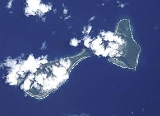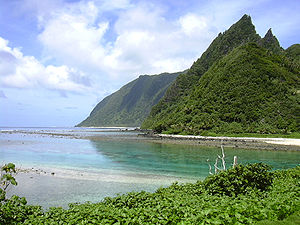
Ofu-Olosega
Encyclopedia
Ofu and Olosega are parts of a volcanic doublet in the Manu‘a Group
of the Samoan Islands
—part of American Samoa
. The twin islands, formed from shield volcanoes, have a combined length of 6km. They are geographic volcanic remnants separated by the narrow 137m wide Asaga strait
, a natural bridge of shallow coral reef
. Before 1970, one had to wade between the two islands at low tide; now a single-lane road bridge over the strait connects villages on Ofu island with those on Olosega.
The highest peak on Ofu is Mount Tumutumu (491m, also referred to as Tumu) and the highest elevation on Olosega is Mount Piumafua (629m). The most recent volcanic eruption took place in 1866, 3km south east of Olosega.
Archaeology
field work carried out in the 1980s yielded pre-historic evidence including ceramics, adzes, shell and bone which have been significant in furthering understanding of the ancient history of the Samoa Islands and Polynesia
. This included samples of red-slipped plainware ceramics that appeared to be in the tradition of Lapita
culture. The work, carried out by a team that included Pacific archaeology specialist Patrick Vinton Kirch
, focused on a site called To'aga (site AS-13-1), a 2km coastal stretch on the south coast of Ofu. The results showed continuous human habitation of about 3,000 years.
 Ofu is the western part of the volcanic outcrop of Ofu-Olosega Island. The main village of Ofu
Ofu is the western part of the volcanic outcrop of Ofu-Olosega Island. The main village of Ofu
is located on the western shore, protected behind an offshore islet (eroded tuff cone) known as Nu'utele
. Ofu has a small airport
and a boat harbor that serve the population on Ofu and Olosega. Before regular airline service was discontinued in 2009, the flight from Pago Pago took about half an hour.
Most of the southern shore and associated coral reef are part of the National Park of American Samoa
. In 2005 the U.S. National Park Service
was negotiating with village councils on Olosega to expand the park around that island.
The island forms the Ofu County subdivision of the Manua District
. It has a land area of 7.215 km² (2.786 sq mi), and had an official population of 289 persons as of the 2000 census
.
Situated on the south coast of the island is To'aga lagoon which has a high diversity of corals and fishes. The marine site has been part of long term research and study on coral reefs and global climate change.
The island is also home to the Samoa Flying-fox (Pteropus samoensis), a species of bat threatened by habitat loss.
, the caldera
of which may lie submerged off the north shore.
The volcanic eruption of 1866 was actually 3 km east of Olosega, on a submarine ridge that extends east southeast to nearby Ta‘ū.
The island forms the Olosega County subdivision of the Manua District
. It has a land area of 5.163 km² (1.993 sq mi), and had an official population of 216 persons as of the 2000 census.
There are two villages on Olosega: Olosega and Sili. Sili, situated on the northwestern-facing shore, now consists of but one standing inhabited residence after much of the village was destroyed by cyclones (and subsequently abandoned).
Almost all the population of Olosega now reside in Olosega village along the southwestern-facing shore.
Olosega village also has Olosega Elementary School with instruction through grade 9 for children on both islands.
Manua
Manua, or the Manua Islands Group , in the Samoan Islands, consists of three main islands: Tau, Ofu and Olosega...
of the Samoan Islands
Samoan Islands
The Samoan Islands or Samoa Islands is an archipelago covering in the central South Pacific, forming part of Polynesia and the wider region of Oceania...
—part of American Samoa
American Samoa
American Samoa is an unincorporated territory of the United States located in the South Pacific Ocean, southeast of the sovereign state of Samoa...
. The twin islands, formed from shield volcanoes, have a combined length of 6km. They are geographic volcanic remnants separated by the narrow 137m wide Asaga strait
Strait
A strait or straits is a narrow, typically navigable channel of water that connects two larger, navigable bodies of water. It most commonly refers to a channel of water that lies between two land masses, but it may also refer to a navigable channel through a body of water that is otherwise not...
, a natural bridge of shallow coral reef
Coral reef
Coral reefs are underwater structures made from calcium carbonate secreted by corals. Coral reefs are colonies of tiny living animals found in marine waters that contain few nutrients. Most coral reefs are built from stony corals, which in turn consist of polyps that cluster in groups. The polyps...
. Before 1970, one had to wade between the two islands at low tide; now a single-lane road bridge over the strait connects villages on Ofu island with those on Olosega.
The highest peak on Ofu is Mount Tumutumu (491m, also referred to as Tumu) and the highest elevation on Olosega is Mount Piumafua (629m). The most recent volcanic eruption took place in 1866, 3km south east of Olosega.
Archaeology
Archaeology
Archaeology, or archeology , is the study of human society, primarily through the recovery and analysis of the material culture and environmental data that they have left behind, which includes artifacts, architecture, biofacts and cultural landscapes...
field work carried out in the 1980s yielded pre-historic evidence including ceramics, adzes, shell and bone which have been significant in furthering understanding of the ancient history of the Samoa Islands and Polynesia
Polynesia
Polynesia is a subregion of Oceania, made up of over 1,000 islands scattered over the central and southern Pacific Ocean. The indigenous people who inhabit the islands of Polynesia are termed Polynesians and they share many similar traits including language, culture and beliefs...
. This included samples of red-slipped plainware ceramics that appeared to be in the tradition of Lapita
Lapita
Lapita is a term applied to an ancient Pacific Ocean archaeological culture which is believed by many archaeologists to be the common ancestor of several cultures in Polynesia, Micronesia, and some coastal areas of Melanesia...
culture. The work, carried out by a team that included Pacific archaeology specialist Patrick Vinton Kirch
Patrick Vinton Kirch
Patrick Vinton Kirch is an archaeologist who studies Oceanic and Polynesia prehistory. He is the Class of 1954 Professor Anthropology at the University of California at Berkeley. He also serves as Curator of Oceanic Archaeology in the Phoebe A. Hearst Museum of Anthropology, and was director of...
, focused on a site called To'aga (site AS-13-1), a 2km coastal stretch on the south coast of Ofu. The results showed continuous human habitation of about 3,000 years.
Ofu

Ofu
Ofu may refer to*Ofu , an island and its village in Vava'u in Tonga*Ofu-Olosega, an island in the Manu'a group in American Samoa*Ofu, Nigeria, a town and Local Government Area in Kogi State...
is located on the western shore, protected behind an offshore islet (eroded tuff cone) known as Nu'utele
Nu'utele
Nu'utele is an island which consists of a volcanic tuff ring situated 1.3 km off the eastern end of Upolu island, Samoa. It is the largest of the four Aleipata Islands, at 1.08 km²....
. Ofu has a small airport
Ofu Airport
Ofu Airport is a public airport located one mile southeast of the village of Ofu on the island of Ofu in American Samoa, an unincorporated territory of the United States...
and a boat harbor that serve the population on Ofu and Olosega. Before regular airline service was discontinued in 2009, the flight from Pago Pago took about half an hour.
Most of the southern shore and associated coral reef are part of the National Park of American Samoa
National Park of American Samoa
The National Park of American Samoa is a national park on the American territory of American Samoa, distributed across three separate islands: Tutuila, Ofu-Olosega, and Ta‘ū. The park includes coral reefs and rain forest and is popular for hiking, snorkeling, and scuba diving, although the primary...
. In 2005 the U.S. National Park Service
National Park Service
The National Park Service is the U.S. federal agency that manages all national parks, many national monuments, and other conservation and historical properties with various title designations...
was negotiating with village councils on Olosega to expand the park around that island.
The island forms the Ofu County subdivision of the Manua District
Manua
Manua, or the Manua Islands Group , in the Samoan Islands, consists of three main islands: Tau, Ofu and Olosega...
. It has a land area of 7.215 km² (2.786 sq mi), and had an official population of 289 persons as of the 2000 census
United States Census, 2000
The Twenty-second United States Census, known as Census 2000 and conducted by the Census Bureau, determined the resident population of the United States on April 1, 2000, to be 281,421,906, an increase of 13.2% over the 248,709,873 persons enumerated during the 1990 Census...
.
Situated on the south coast of the island is To'aga lagoon which has a high diversity of corals and fishes. The marine site has been part of long term research and study on coral reefs and global climate change.
The island is also home to the Samoa Flying-fox (Pteropus samoensis), a species of bat threatened by habitat loss.
Olosega
Olosega Island is a remnant of the Sili shield volcanoShield volcano
A shield volcano is a type of volcano usually built almost entirely of fluid lava flows. They are named for their large size and low profile, resembling a warrior's shield. This is caused by the highly fluid lava they erupt, which travels farther than lava erupted from more explosive volcanoes...
, the caldera
Caldera
A caldera is a cauldron-like volcanic feature usually formed by the collapse of land following a volcanic eruption, such as the one at Yellowstone National Park in the US. They are sometimes confused with volcanic craters...
of which may lie submerged off the north shore.
The volcanic eruption of 1866 was actually 3 km east of Olosega, on a submarine ridge that extends east southeast to nearby Ta‘ū.
The island forms the Olosega County subdivision of the Manua District
Manua
Manua, or the Manua Islands Group , in the Samoan Islands, consists of three main islands: Tau, Ofu and Olosega...
. It has a land area of 5.163 km² (1.993 sq mi), and had an official population of 216 persons as of the 2000 census.
There are two villages on Olosega: Olosega and Sili. Sili, situated on the northwestern-facing shore, now consists of but one standing inhabited residence after much of the village was destroyed by cyclones (and subsequently abandoned).
Almost all the population of Olosega now reside in Olosega village along the southwestern-facing shore.
Olosega village also has Olosega Elementary School with instruction through grade 9 for children on both islands.
External links
- Office of the Governor. 2004. Manu‘a ma Amerika. A brief historical documentary. Manu‘a Centennial. 16 July 1904. 16 July 2004. Office of the Governor, American Samoa Government. 20 p.
- http://factfinder.census.gov/servlet/DTTable?_bm=y&-context=dt&-PANEL_ID=p_dt_geo_map&-ds_name=DEC_2000_IAAS&-CONTEXT=dt&-mt_name=DEC_2000_IAAS_P001&-tree_id=405&-errMsg=&-transpose=N&-redoLog=true&-all_geo_types=N&-geo_id=06000US6002059300&-geo_id=06000US6002060900&-search_results=04000US60&-format=&-_lang=en&-search_map_config=|b=50|l=en|t=4001|zf=0.0|ms=sel_00dec|dw=0.9528487917191559|dh=0.6838460131961157|dt=gov.census.aff.domain.map.EnglishMapExtent|if=gif|cx=-67.48042614595042|cy=18.385966173167105|zl=6|pz=6|bo=318:317:316:314:313:323:319|bl=362:393:358:357:356:355:354|ft=350:349:335:389:388:332:331|fl=381:403:204:380:369:379:368|g=04000US72&-show_geoid=YOfu County and Olosega County, Manu'a District, United States Census Bureau]
- National Park Service map of the Manu‘a Islands
- Persistence of Coral Reefs Under Extreme Environmental Stress in American Samoa G. Piniak, C. Birkeland, and G. Garrison (2004). University of Hawaii.

